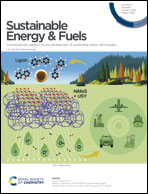Methane-trapping metal–organic frameworks with an aliphatic ligand for efficient CH4/N2 separation†
Abstract
CH4/N2 separation is one of the great challenges in the gas separation field due to their very close physical properties. In this work, a strategy was proposed to construct specific cages using an aliphatic ligand with suitable size to preferentially adsorb CH4 molecules in metal–organic frameworks (MOFs). As a result, a series of MOFs with trans-1,4-cyclohexanedicarboxylic acid (H2CDC) as the ligand and different metal centres (M-CDC, M represents metal ions) exhibit excellent separation performances for CH4/N2 mixture. To the best of our knowledge, the presented MOFs possess higher selectivity (13.1–16.69) and sorbent selection parameter (SSP) in comparison to the reported porous materials. Especially for the integrated descriptor SSP, the value of Al-CDC is up to 82.0, which is at least 2–3 times higher than those in the reported materials. Breakthrough experiments indicate that CH4/N2 can be completely separated using a packed column of Al-CDC. Theoretical calculations confirmed the preferential trap of CH4 in the cages formed by the aliphatic ligand. In addition, the separation performance can be well maintained even after at least 10 cycles and the treatment of the MOF sample with boiling water, acid and base solution. These results not only introduce promising candidates for CH4/N2 separation, but also provide useful information for the separation of other weak adsorbates with similar properties.



 Please wait while we load your content...
Please wait while we load your content...